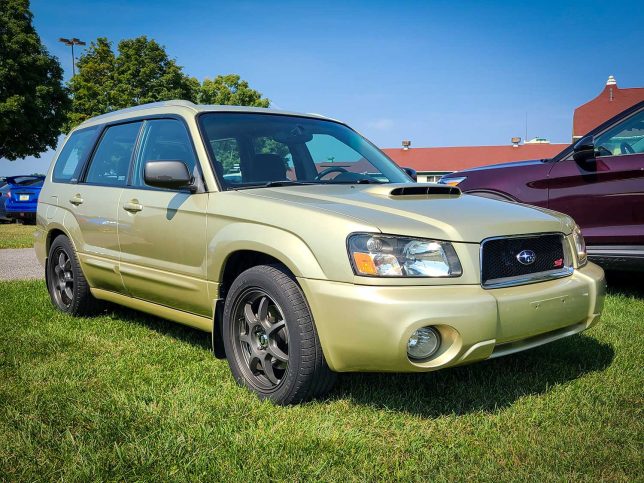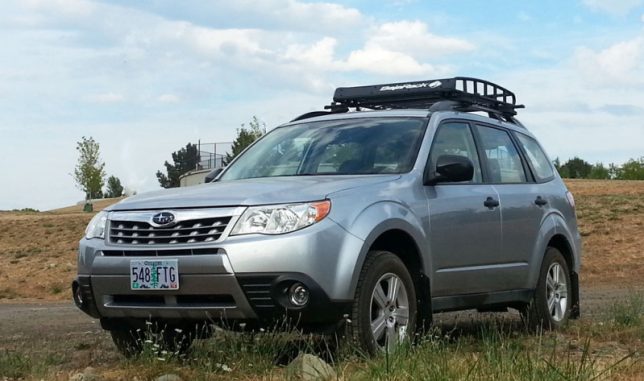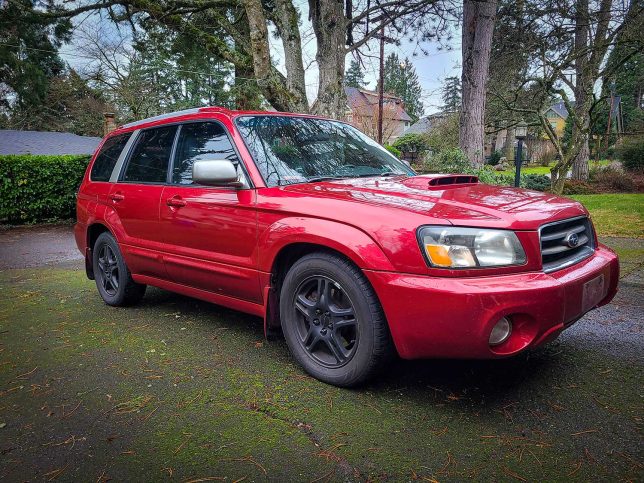For 23 years, we had a sporty on-road car of some sort. While sporty didn’t necessarily mean fast, it always meant upgraded suspension and stickier tires at a minimum. Whether it was my SR20DE-powered Nissan Sentra SE-Limited or 2001 Ford Focus ZX3, our 1998 Honda Prelude SH, or 2013 Subaru Impreza WRX, we always had an on-road corner carver. But in August of 2022 that changed. We sold our modified (and surprisingly sporty) 2007 Toyota Yaris after 14 years of ownership leaving us with four vehicles on knobby dirt tires. We were without an on-road corner-carver for the first time in over two decades. Well, we made it about 16 months and two weeks before the desire for a sporty, fun, and quick car beckoned. Last week, we bought a 2005 Subaru Forester XT. Sure, the Forester was originally touted as an SUV or crossover. But the 2004+ XT versions were pretty quick out of the box thanks to an engine/transmission similar to the WRX. This vehicle will be mostly relegated to on-road activities. This isn’t our gravel-travel car. We have plenty of those. This is our grip machine, our canyon carver, and our boost bucket. (OK, maybe a gravel TSD or two.)
The New-To-Us Forester XT
Our new-to-us Forester has a healthy 190,000 miles on it. However, it had a fair bit of maintenance and has the paperwork to prove it: timing belt, water pump, air conditioning, wheel bearings, brakes, and more. I’m not sure if the heads have been done. We set money aside for them. After all, I know what I’m getting myself into. Sorta.
This car is modified with high-quality parts from reputable companies. The up-pipe, down-pipe, intake, blow-off valve, and exhaust are all upgraded. It’s got a tune. I’m told it should make around 300-wheel horsepower—and it certainly feels like it! It rides on coilovers, has an upgraded front sway bar, and a few other goodies.
Even on the test drive, it became apparent how much of a kick in the pants it was to drive. All three of our JDM cars combined make about the same amount of horsepower as this Forester. It makes all the turbo noises. It’s so fun. As Crankshaft Culture contributor, tuanies said, “Do you even know how to drive a car with that much power?” Well plaid, Tuan. Well played.
Still A Project
Make no mistake, this is still a 19-year-old car and is a project. The climate control panel has some bugs I need to look into. There was a bit of water in the spare tire well. The synchro in first gear seems to be a bit wonky. There’s a small tear in the driver’s seat. But these are all things I can work on. Hey, it keeps me off the streets.
We’re excited to have a fast, fun car again. Plus, we resurrected our Oregon Wine Country plates for this wine wagon; the same ones that were on our WRX and Mirage.
About the 2004–2005 Forest XT

Introduced in 2003 for the North American market, the second-generation (SG) Subaru Foresters came with a normally aspirated SOHC 2.5-liter horizontally opposed four-cylinder engine (EJ251). In 2004, the Forester XT debuted with the turbocharged DOHC EJ255. (It used the same block as the 2004–2006 WRX STI.) The cars produced 210 HP and 235 lb-ft of torque and could be had with a five-speed manual or four-speed auto. This setup was available in 2005 as well. In 2006, power went up to 230 HP.
This Is our Second Subaru Forester and Fourth Subaru

Back in 2012, we bought a new third-gen Forester, our first Subie (ironically, we went to buy a new Crosstrek). It was a non-turbo 2.5X model but had a manual transmission. It was the right car at the wrong time, and we traded it in on a 2013 Impreza WRX just a year after buying it.
The WRX was the right car at the right time and was the fastest, most powerful car either Mercedes or I had owned. We put Oregon Wine Country plates on it, took it up to Canada on our 10-year wedding anniversary, and drove it down to California wine country for fun. It got the nickname the “Wine Wagon” because of our wine-related travels (and license plates).

We had a lot of fun with the WRX, but we didn’t drive it all that much as gas was expensive, and our Yaris was so frugal. So, in 2017 we sold it, took $9,600 of the money and bought a very frugal 2017 Mitsubishi Mirage as a commuter, and put some of the money in the bank, and the rest went toward our 1989 Mitsubishi Delica, the Space Tractor.
Eventually, we’d sell the Mirage and the Yaris, and purchase our 2022 Crosstrek with the six-speed manual as our third Subaru. It isn’t fast, but it’s been a great cross-country vehicle as well as a fun TSD rally rig.
When One Vehicle Arrives, Another One Leaves
We don’t need (or want) five cars at this point. Buying another sporty car was contingent on selling an existing car in the fleet. Since we have two gen-two JDM Mitsubishi Pajeros, we decided to part ways with one of them. So we’ll be selling our 1992 Pajero XR-II, aka the Ralli Tractor, and keep our 1991 Pajero XP, aka the Terra Tractor, aka our 2020 Alcan 5000 rig. The Ralli Tractor has been a great rig, has a new engine, a new radiator, and a host of other parts. But the time has come to part ways with it. Over the next couple of weeks, I’ll prep it for sale. Interested? Send me an email.
So here’s to our new Forester and new adventures. After all, every vehicle is an adventure, and no matter what we drive, we’re all united by horsepower.

Andy Lilienthal is an award-winning writer and has written professionally since 1999. He has over 13 years in the automotive aftermarket working at companies including Warn Industries, Bushwacker, and Lund International. Editorial works include writing and photography for off-road print magazines, to new-car reviews online. He’s a photographer with images in multiple magazines, blog sites, and The New York Times.


Leave a Reply